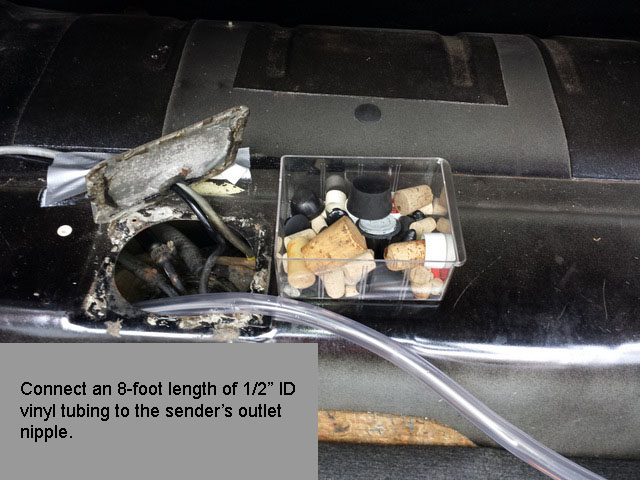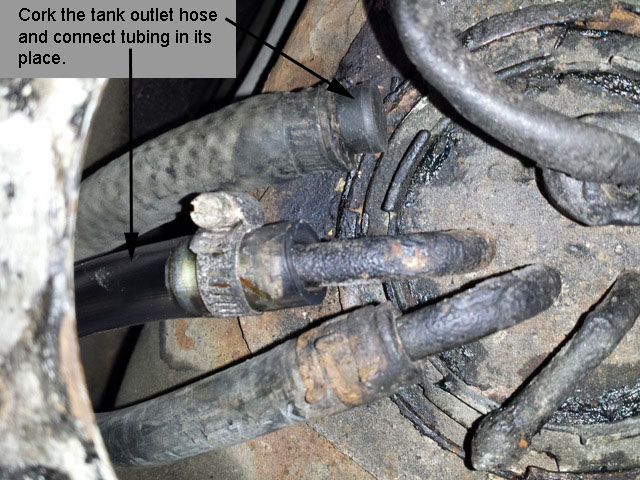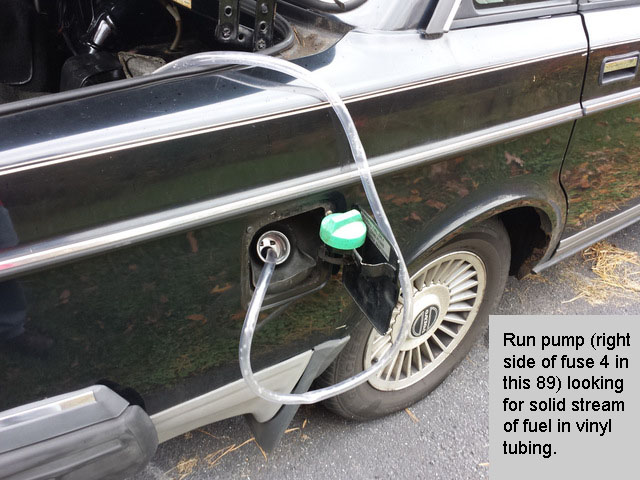|
|
|
Hey all,
I am officially stumped here.
Last Thursday my 1986 240 was running fine. Shut her off for a bit, ran into store came out......refused to start(still warm). I finally got her to pop off, drove her home with ZERO ISSUES. It was as if nothing happened. Ok great problem solved.ha think again..... Got in driveway and shut her down than immediately tried to restart. NOTHING. And now she won't start for the life of her.
Things I've tried so far: swapped out fuel pump relay and I reflowed both the old as well as replacement fuel relays(" new" relay is a 2000 made one), all wiring looks a-ok, replaced a cracked element euro fuse, unplugged MAF sensor(not the issue), checked fuel pump/engine management fuse,
Hall sensor connector is fine.
The odd part is everything is checking out. Timing is not off and I'm not suspecting fuel pumps as they would affect drivability. It sometimes smells BAD like fuel, than it dosent.
What's going on here?
|
|

|
|
Your first step should be to thank the Norse gods it isn't starting now; that the problem is no longer sporadic. You should use that opportunity to gently diagnose and not bump something to "fix" it.
Second step should be to determine if it is missing fuel or spark, given you're certain the mechanical timing (compression) has not changed. Simplest way is to inject some starting fluid. If you have a timing light, you could also check spark that way.
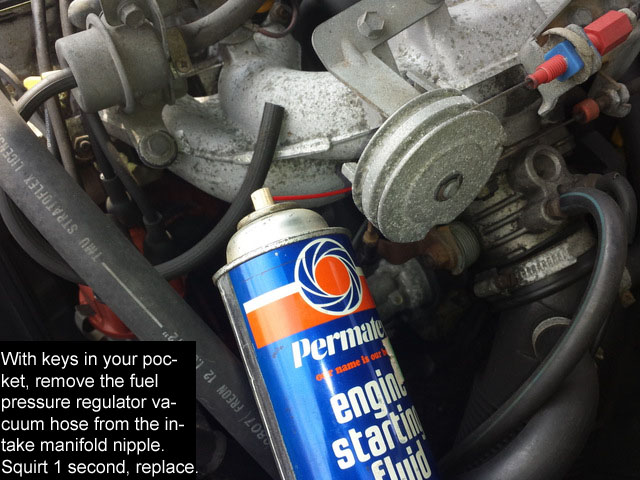
--
Art Benstein near Baltimore
SUCCESS:
At age 4 success is . . . not peeing in your pants.
At age 12 success is . . . having friends.
At age 16 success is . . . having a drivers license.
At age 20 success is . . . going all the way.
At age 35 success is . . . having money.
At age 50 success is . . . having money.
At age 60 success is . . . going all the way.
At age 70 success is . . . having a drivers license.
At age 75 success is . . . having friends.
At age 80 success is . . . not peeing in your pants.
|
|
|
|
|
To rehsper's ???
It cranks fine just won't fire.
Art, I will try that I'm just curious as to why she suddenly died started back up like nothing happened than won't restart. It's like if I had left the key on 24/7 she'd stay running. Well until the obvious but point is*scratches head*
|
|
|
|
|
Always carry a new cap & rotor,,I bet over time the metal pieces wear & occasionally start & stop,,So if everything else is good,I bet the spark is weak there.
|
|
|
|
|
Could very well be. I just went back out there cleaned up the 25a fuel pump fuse and holder, tested coil, there is 12v present.
Tried to start and she coughed for a second literally, smelled like chemically fuel and nothing more.
I will try checking the spark when the wife gets home with my tester(gap type)
I did not use ether yet I need to get a can.
Hmmmm.....
|
|
|
|
|
Update: I figured since I had no ether I'd use the next best thing. Carb cleaner. Well she popped right off.
Again hmmmmm because I do smell fuel like I mentioned before. I'm wondering if the main pump may have finally kicked the bucket.
|
|
|
|
|
Ok +12 at Orange wire of AMM....check
Jumped fuses... Both pumps run.
Tried starting....nada.
At least the pumps are not bad or at least so it would seem.
Hmmmmmm..... The Volvo gods are not on my side this time. Lol.
Any more suggestions.
|
|

|
|
Now it is time to follow your nose.
You probably can't test fuel pressure, but you can sniff a spark plug to see if you're getting any squirted in the cylinder. Can you tell the difference between residue from carb cleaner and fuel? I doubt it is being flooded, for if that were the case, I think the carb cleaner wouldn't have been burned.
One way to judge fuel pressure is to squeeze the fuel RETURN hose while running the pumps with the jumper. Squeeze it momentarily to see if you feel fuel being returned to the tank. It isn't conclusive, but a little safer than cracking the fitting and looking for a 40-lb squirt rather than a dribble from the rail. Do you understand how the fuel pressure regulator works?
Beyond that, there are cars built (all the Volvos) between 81 and 87 which have deteriorated insulation inside the vinyl sleeves of the main engine wiring harness. If you get that far as to suspect that (injector wiring can short out) I'll post a pic of what that looks like inside.
Run the pumps with the jumper. The picture shows a '91 with LH2.4, and your LH2.2 will look a bit different, but be the same in function at the rail.
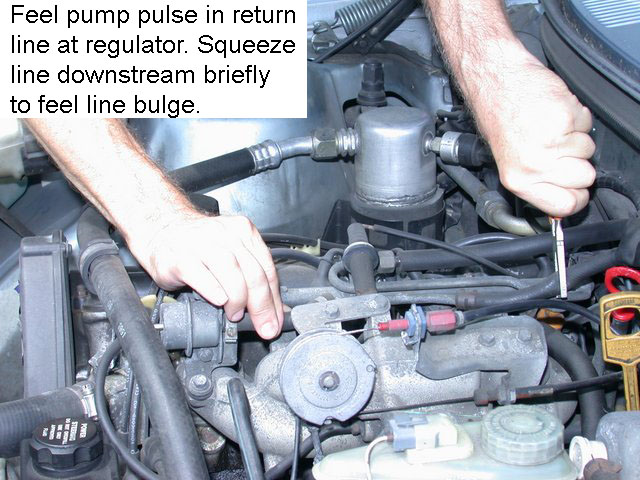
--
Art Benstein near Baltimore
In The Tank
|
|
|
|
|
I rejumpered the pumps and the line I'm assuming is the rubber hose going to the rear of the FPR correct? That's the only line I see fuelwise.
In any case not a damn thing. I squeezed with a pair of pliers. No pulse and it was not hard at all.
Yes most definitely both pumps are running I can hear the intank inside the vehicle and the outside main one I hear as well unless the main is resonating inside. I did do a listen from the filler neck with a snow brush though.
|
|

|
|
Next step is to do a volume delivery test. You'll have to disconnect the high pressure hose from the rail, and route it to a gas can through a larger hose, like the clear vinyl type you can get in the hardware store. You won't be measuring pressure, but are looking for a generous volume of fuel being passed through the filter from the main pump. In 60 seconds you should be able to fill a gallon can halfway. If it doesn't, you could have a problem in the tank, especially if the main pump seems to make a raucous noise.
In The Tank
--
Art Benstein near Baltimore
"Humor is the universal solvent against the abrasive elements of life..." -Alan Simpson
|
|
|
|
|
Art,
By the line going to the rail I'm assuming you mean the rubber line ahead of the FPR correct? I was going to swap the FPR out for the hell of it but apparently the ones for the 740 won't work on a 86 240.
Geoffrey
|
|
posted by
someone claiming to be Art
on
Wed Dec 5 18:32 CST 2018 [ RELATED]
|
|
Geoffrey,
The high pressure line is the fat insulated line connected to the shepherds crook shaped pipe on the fuel rail. You'll need line wrenches size 14 and 17. Fuel is dangerous. You might want to farm this out.
|
|
|
|
|
Art,
Oh ok. I will check tomorrow.
I was doing the "pinch" test on the rubber line that I'm assuming goes between the main pump and FPR. If it's the same as the 740.
I never got into this much detail on the fuel system. I'm not positive if I am all that comfortable with pulling that line. Is there a fitting to test the pressure somewhere? I think I might have a fuel pressure gauge somewhere. If not I can always pay a visit to harbor freight or the zone.
Geoffrey
|
|
|
|
|
Hi,
I've read the posts above and noticed Mr. Benstein's advice that you take out a plug or two after cranking to see it they are wet. Perhaps I missed it, but I don't see the results of that simple test.
Dry plugs would lead me to think about fuel pressure, injector wiring, pumps, filters etc., but if the plugs are wet, as they should be, I think I would pause and ask why the engine will kick on ether but not the fuel coming from the injectors.
I've experienced two situations with 240's where perfectly functioning ignition and fuel systems have produced no-start conditions.
The first was when staying later than expected at a gathering and realized my fuel was low and the gas stations were closed. My host offered me 5 gallons of gas from his barn and I accepted it. The car started, I drove home but it would not restart, and I'm embarrassed to tell you how many hours I spent before realizing the fuel I'd put in was diesel.
The second case has happened twice and both times involved being unable to restart the morning after extended idling or low rev city driving in below 0 weather. Other common features were under axel exhaust systems, and high winds. In these conditions the water in the exhaust can condense, freeze, and expand at the low point of the system, blocking future exhaust and start up.
These are odd and rare cases and unlikely your problem, but I do think it worthwhile knowing if your plugs are getting wet.
regards, Peter
|
|

|
|
" In these conditions the water in the exhaust can condense, freeze, and expand at the low point of the system, blocking future exhaust and start up. "
Wow, that's one I never thought of! Thanks.
--
Art Benstein near Baltimore
“Always code as if the guy who ends up maintaining your code will be a violent psychopath who knows where you live.” - John F. Woods
|
|
|
|
|
Art,
Very well could have been ice. But I forgot to mention that my exhaust is completely gone from cat back. It's one of those I've got bigger fish to fry deals. Eventually I will replace it.
Could it possibly be a lazy pump?
|
|

|
|
Geoffrey,
I wasn't really thinking the ice in the pipe was your car's trouble, just a most interesting idea in general about the under-axle exhaust plumbing I'd never given any thought to. There's a regular debate, discussion, or examination of the pros and cons of Volvo's current choice to stock only the more universal over-axle cat-back system. I'd never heard of this particular issue, and have this image in my head of half-a-gallon of water collecting and being forced out on startup, and what that must look like in the driveway.
I'm sorry to hear in this subthread your problem starting has disappeared. Not that I want your car not to start, but like I said in my initial response, you're most lucky when a sporadic trouble becomes static. Unfortunately now you're back to guessing games, like that guess you just took, "lazy pump." I can't help you guess, only help you troubleshoot methodically. Everyone else will contribute guesses. Like Peter said, when we suggest doing something, give a response after you've had the opportunity of doing it. Did you read the link I gave a couple times earlier? In The Tank
--
Art Benstein near Baltimore
Sometimes, the good you do does you no good. -Dr. Phil's way of saying no good deed goes unpunished.
|
|
|
|
|
Art,
Yeah that would be a sight LMFAO. Could be something to the nature of a water connon possibly.
Yes I did read the link you sent me. I will study all that everyone has contributed in this thread now she seems to be fine. I still don't trust it won't happen again though, probably down a dark road at 2 am we all know how that goes.
Thanks everyone for all the help and input😀 every bit helps.
|
|
|
|
|
Well just as I suspected, she's up to her old tricks again.
She was starting/restarting perfectly than I shut her off to deposit the wife's check and BAM. Same issue as before.
Gonna try to get a gas can and get her above 1/2 tank of gas.
|
|
|
|
|
Got 5 gal in her. Popped right off when above 1/2 tank. I'm suspecting intank pump. What does everyone else think?
|
|
|
|
|
Update: haven't gotten around to anything as there was a huge blizzard. I was waiting for new pumps to arrive.
I ordered BOTH the main as well as intank pumps. Yes I went with El cheapos for the time being just to see if that is actually the issue. If she gets running fine than I shall order up good Bosch or carters.
Soon as this snow melts a bit:(we got A LOT mostly drifts but it's like waist high in the driveway where I did not plow out)
Phil,
Ok I will try redoing the intank pump FIRST.
She's plumb full of gas as I only drove her about 30 miles before she chugged out and refuses to run since.(had to tow rope her home the last few miles lol)
Otherwise I really do not know what to try other than replacing BOTH pumps and filter. We've covered pretty much everything I can think of.
|
|
|
|
|
Hi,
The half a tank fun is a pronounced symptom that gets better on hills or even slight grades.
I think you have a very good reason not to procrastinate any longer on opening up that fuel tank and inspecting the works in there!
It could be just the rubber connector hose or the pump itself. Cheap fix!
Talking about rubber, you for sure, will want to change the bung cap “O” ring and it’s not even submerged in gasoline. They do crush down and aquire cracks in them over the many years.
So, with those two rubber products to order, why not a pump too?
I would do this and be done with the problem of being so antagonize with the inconvenience it presents you and you describe in the previous post.
This car is not going to be convenient enough to breaking down in front of the your house or at a parts house!
The odds are just against that happening, unless you don’t go anywhere else to be hanging out with parts buddies.
I hope you have gotta better plan in like keeping the tank full.
This was said the in my first post and then you went with worries of quality on brand pumps to purchase. What not fixed yet?
I think I covered the pros and cons to help you out with what brand to buy in pumps as there is no choice in rubber products. You kinda get to take what you can get.
So!
Plan A is now including a peek-in and look with or with out parts in hand.
Plan B Is like carry an extra full can of gas in the trunk or wait for the main pump to succumb to failure from cavitation.
The main pump has rollers and windings that are made to be flooded with gasoline to be cooled and lubricated to operate comfortably.
Without these attributes, the life of the main pump gets severely shortened!
This is like arm wrestling?
Your choice of when to do this, will be when something else yells, “When.”
If you have to keep over cranking the car all the time, the starter can go bad ...when?
A badly tuned up engine does the same thing.
Phil
|
|
|
|
|
Ok just tried starting her again. Fired right off cold start. Shut her off and again fired right up.let her warm up for about 5-10 mins( temp gauge centered completely) shut off restarted, fired right up.
As Alice said.....curiouser and curiouser.
|
|

|
|
Checking the pressure (measuring it) is not really necessary to get a dead motor running, because anything in a large range will get it started. Precise measurement is needed to ensure it is running well and efficiently.
The setup is the same for all EFI cars of the era, same as your 7-series Volvo. A low pressure lift pump moves fuel from the tank through a very short rubber hose to a fitting at the top of the tank, and from there, a large rubber hose to the inlet of the main pump under the rear seat.
The main pump's output connects to a large fuel filter mounted in a tray next to it. From there, a nylon pipe conveys the pump's high pressure output to the fuel rail where the electrically opened injectors are attached. This nylon pipe has a soft rubber insulating cover over the last three feet of it where it is routed through the engine compartment.
To limit the pressure, the regulator sends the fuel that isn't used by the injectors (most of it that is) back to the tank through a short rubber hose and a long steel pipe. The regulator releases the returning fuel as the rail pressure exceeds 3 atmospheres (in your car and the 740) higher than the pressure (vacuum) in the intake manifold. This exact pressure difference is needed so the amount of time the injectors are opened by the computer exactly measures the amount of fuel injected.
The high pressure fittings are metal flare joints, and those used by Volvo (Bosch) are not common to all the cars making up the market Autozone and HF serve, so you'll probably not be able to easily find adapter fittings to tee in a gauge. Check out the special tool shown below.
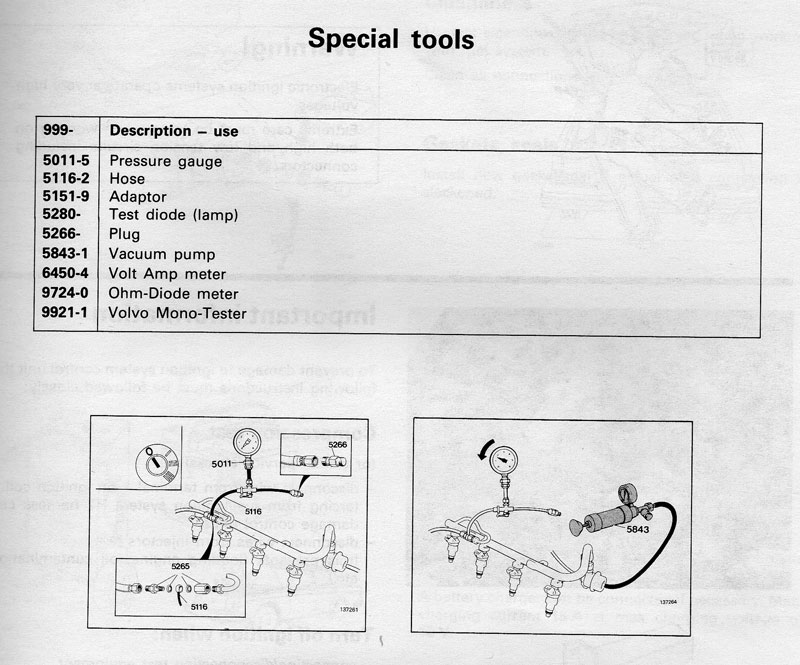
You do not want to squeeze, kink, or cut that nylon pipe. The fuel rail is soft metal as well, and easily damaged, so to disconnect the flare fitting, you'll need two wrenches to act against each other.
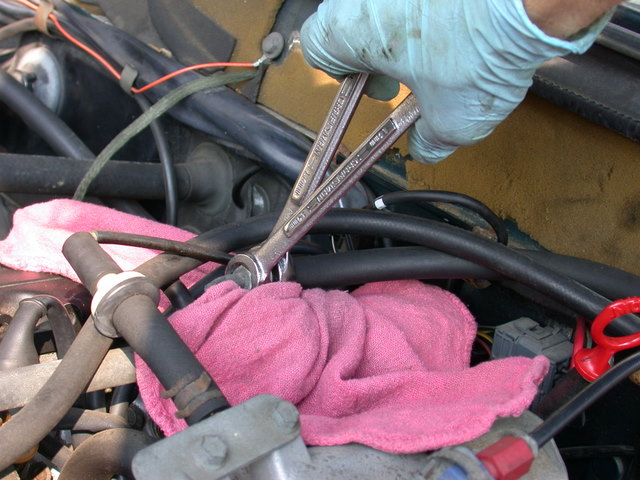
If you're into building special tools instead of buying them, I owe my adapter to a suggestion I received on this forum in '99 -- to make one out of a junkyard fuel rail.
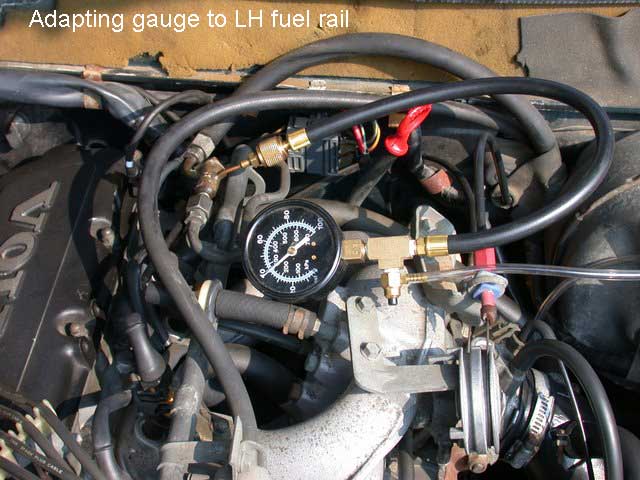
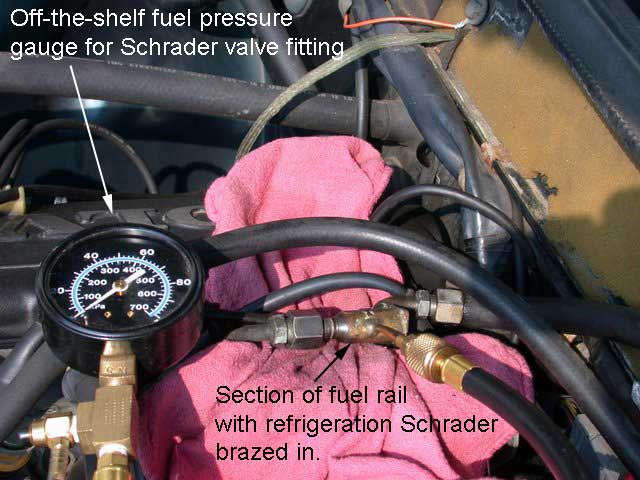
A very inexpensive text on Bosch fuel injection is published by Bentley. Bosch Fuel Injection & Engine Management by Charles O. Probst.
--
Art Benstein near Baltimore
Mothers of teens now know why some animals eat their young.
|
|
|
|
|
If your car has a cold start valve you can use that fuel line to connect your pressure gauge.
--
Current rides: 2005 Volvo S80 2.5T, 2003 Volvo V70 2.4NA, 1973 Volvo 1800ES (getting ever closer to road worthiness)
|
|
|
|
|
Hi Chris,
If my memory serves me, I don't think the LH 2.2 has a CSV.
Peter
|
|
|
|
|
Oh almost forgot:
If the main pump is the issue what are your opinions on isumo (EBay/Amazon) pumps? I think I spelled it correctly. Any good or cheap china-shit knockoff.i know they are China made.
If intank I'm thinking the pump is the same as on the 740 and NAPA at least used to have a Carter cheap when I did the one on my old 740.
|
|
|
|
|
Hi,
You have asked the very question that every one always has to answer for themselves, through trial and error.
When it comes to cost over quality, you have to put some figures in between the $ sign and the decimal point that are not numerically definitive.
On the in-tank pump these type pumps are not as highly critical in their function or need to perform to critical standards.
So they are pretty much generic across the board by all manufacturers. Whether it’s Airtex, Carter or AutoZone’s who Knows what manufacturer, you are going to get a functional part that can or cannot be reflected in its price. In both cases you have to consider its sources and marketing values.
The main pump on the other hand is another story. It has to work every time to be dependable.
It uses a good amount more power because it does a lot more work! I my opinion you want to stay as close to an OEM pump design and quality that has proven itself over time.
So far Bosch has led the way with many of their products. While at the same time, keeping in mind that if you go to high in pricing someone is bound to under cut your products and in many cases, beat you at your on game!
Time is one of those figures going into the cost amount. It is the amount of service and kind of performance you will want or expect on demand!
Do you go to the store a lot, when it’s really a short walk or take long trips somewhere to which walking is not a planned idea!
In Alaska or most desolate places, you want good dogs tied to your sled!
Phil
|
|
|
|
|
Phil,
Thanks for that. Yeah I figure I'll keep with Bosch for the main pump as I also agree Bosch still does make very reliable parts (although I heard they went bankrupt or got bought out, defunct????? What's up with that)
And no I certainly do not go strict short distances lol. The store I was at was like 30 miles from home😀
|
|

|
|
Now you know it is fuel. From my vantage point I would discount* your fuel smell symptom, believing you don't have much of history of sniffing things when they're working.
If this 86 were my ride, I'd now verify the power to the fuel system by checking for battery voltage at the AMM's orange wire. Of course, if it were my car, I'd know whether the main engine wiring harness had been replaced, its original having lost most of its insulation. First check would be for the power at the orange wire, and then, if OK, I'd jump fuse 4 to power at fuse 6 to hear the fuel pumps running, and if they did run, I'd try starting with that jumper in place.
Turn the key on and look for power here:

If that's OK, then run the pumps like this:
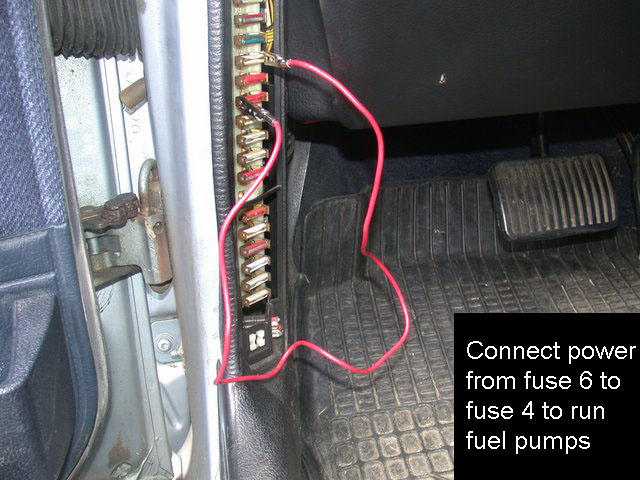
* Don't mean to dismiss, just discount, because my nose isn't there. Seriously, you could be understating the odor and I'd never know it. A rodent chewed through the nylon high pressure line on our 89 wagon last month. The leak was smelly all right, but not large enough to keep the motor from running.
--
Art Benstein near Baltimore
"I been in the right trip but I must have used the wrong car." -Dr John
|
|
|
|
|
Some great rip offs here!!
I will study and go through the tips that Phil and art have suggested at one point today. Thanks art for providing the detailed pics as I lost the information as to which fuses to jump.
Come to think of it, I do not hear the main pump going like it did before. I know ever since I got the car back in 13 that the main pump would run weird like ree reee and also the interior light would slightly flicker.
The harness it's hard to tell but I will say everything looks perfect.
Bit of history of the car is as follows: when I purchased my 240( it's a wagon btw) the previous owner told me it was originally an Arizona vehicle and old insurance cards confirm that fact. He bought it from friends whom were moving to s. Africa and we're going to junk it(couldn't take with). And he drove it and it sat for 2 years prior to me buying it.
Being an Arizona vehicle would explain the lack of rust compared to East coast/Midwest. I haven't the foggiest if they ever replaced any harnesses. I'm assuming no due to the dry desert conditions. But all rubber is still pliable and "as new".....that I can see. Never had issues.
I'll post the results here soon as I get to testing everything that was mentioned.😀
|
|
|
|
|
Hi,
I see no reason for you not to think low fuel pressure or a lazy starting up pump, if it has a lot of age on it.
The combination of Low pressure and/or volume, could explain the smell if the injectors are not getting a full shot at making a nice fine spray.
The trick when starting fluid is that if proves you have spark timing and are missing fuel timing or that it could have been the other way around if it had not hit and not ran on that short burst of fuel.
Since it sounds like, if it kept running, you didn't make that clear, that the pump seems to be able to catch up to filling the fuel rail.
The trick is with the smell remaining the system may be a fact that atomization is insufficient.
You may need to pull the plugs to see if they are gas fouled or carbon fouled or sooty.
There are few other things that can cause low fuel pressure besides only an old pump.
Output restriction due to a dirty filter, of which, is seldom the case because, they are so large it's hard to plug them up.
The in-tank pump may not be working and if below a half tank of fuel, this can become a real issue.
It also has a filter sock that might be clogged if the tank is rusty inside.
There is a rubber hose, that connects up the pump to the output line that can introduce air bubbles or lack of priming fuel. Low amounts of fuel in the tank and a long steep hill gets one's attention if it's a problem.
Next would be a leaky fuel pressure regulator. This gets quite a few engines issues. It can be sending to much gas back to the tank causing starvation or a leaking down of rest pressure.
Severely between short time starts is rare so, Severely, seldom happens for this case of running into the grocery store and right back out!
A different one is it can be more of a total failure of the diaphragm and this will cause flooding, of which, explains a the no/hard too start and very much so the smell! The car will get terrible mileage.
Checking the vacuum line from the FPR to the intake for fuel smell or gas.
Removing the return line and see if the FPR leaks and blowing air towards the tank to make sure it's clear is suggested by the Bentley repair manual to cover all the bases for running too Rich.
A fuel pressure check of the fuel rail would be the best test to see if the FPR is in the ball park of doing its job of actually holding some rest pressure between starts. Its responsibility is keeping the fuel rail full of volume up that the pump does not have to play catch up too.
There is also a main fuel pump check valve right on the main pump outlet that also shares this responsibility.
It's pretty reliable but we might be talking lots of age here! The tiny spring inside can wear thin on one side and break into. I had that happen at around 220k on my 1978 many years ago.
This would cause an immediate hard to start every time you try.
I hope I didn't give you too much to ponder but I'm in my armchair trying to get sleepy enough to stop playing with scenarios!
Just have to get out there and spread your hugs around to different places until you find it!
Phil
|
|
|
|
|
When you say "NOTHING" do you mean truly nothing happens when you turn the key, no lights, no clicks or do you mean it cranks but it doesn't try to fire?
|
|
|
|
|




